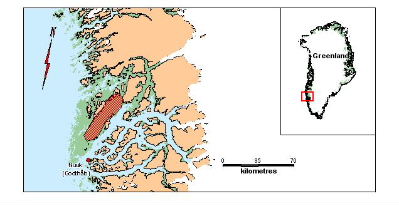Summary
In March-April 2008, the Greenland Institute of Natural Resources (GINR) examined the Akia-Maniitsoq caribou population in West Greenland for body condition and health using CARMA protocols. We collected 41 caribou cows and 6 female calves from the Central region (ca. 64° 44' N; 51° 32' W), which is immediately north of Greenland's capital city, Nuuk. Initial data included the following information; date, location, elevation, sex, age classification (calf, sub-adult or adult) and the presence, absence or condition of antlers, calf-at-heel, milk in udders or calf antlers (see field data sheet). A photo record for each animal was kept. Important parameters included body, bone, fat and organ weights and measurements, tooth wear, and body condition score. Samples collected included blood, muscle, liver, kidney, urine, rumen contents, bone marrow, bone (mandible, metatarsus), ovaries, foetal tissues, feces, abomasums, small intestine contents, milk and hair. We checked for a variety of parasites including protozoa, nematodes, tapeworms, flukes and flies (e.g., besnoitia, lung worm and hydatid cysts, liver flukes, liver cysts, Tænia cysts, Seteria worms, Sinus tapeworm, warbles & bots). The disease Brucellosis (never observed in Greenland) was assessed by visual appraisal, while blood or fecal samples allowed testing for other pathogens and Johne's disease. The latter was surprisingly prevalent among the sampled animals. Analyses for tooth ageing and marrow fat content have been completed, while retrospective analysis of the ovaries was begun autumn 2009. Although not yet complete, intended analyses include environmental contaminants, nitrogen isotopes in urine blood and muscle, DNA, milk fat, and parasite or disease presence in tissues collected.
The Akia-Nordland area (red hatched region) where 40 caribou cows from the Akia-Maniitsoq herd were collected in March-April 2008 for a body condition, health and reproduction study.
This caribou collection and analysis was funded by GINR and CARMA (CircumArctic Rangifer Monitoring & Assessment). Participants included GINR project leader and scientist Christine Cuyler and Greenland's Sisimiut hunting officer Hans Mølgaard of GFLK (Grønlands Fiskerilicens Kontrol), scientists Wendy Nixon (CWS Yukon Territory, Canada) and Robert White (Univ. of Alaska Fairbanks, USA), Finnish PhD student, Elina Kaarlejärvi, and biology assistants from GINR, Sofia Ruth Jeremiassen, Tuperna Larsen and Lars Maltha Rasmussen (GINR); assistants from GFLK, Eivind Jensen., Ado Holm and Ludvig Hansen. GINR's own boats and skippers Lars Heilman andFlemming Heinrich provided fjord transport. Nuuk hunting officer Vittus Nielsen (GFLK) also provided daily boat transportation for personal, skidoos, sleds and caribou no matter what the conditions.
Hans Mølgaard, hunting officer from Sisimiut, with several caribou collected for a CARMA supported study of body condition, health and reproduction in caribou from the Akia-Maniitsoq herd, West Greenland. Terrain and snow cover are typical to the Akia-Nordland study area. Photo by C. Cuyler.
Results
Our collection period was 29 March - 13 April 2008. We examined the Akia-Maniitsoq caribou population in West Greenland. We culled 47 caribou, which included 41 cows (34 adults and 7 sub-adults) and 6 female calves, i.e., animals about 10-months old. To obtain the animals, an average of 104 km were travelled each day by snowmobile. There was additional boat travel to reach the study area. About 300 to 400 caribou in total were observed. Average group size was 4 ± 2 S.D. caribou. The animals were "shy", which resulted in an average shooting distance of 216 ±77 S.D. metres. Maximum shooting distance was 390 metres (measured by laser distance finder). Waterproof tags for labelling animals during transport to the laboratory proved necessary. The data is still being processed, while some samples have not yet been analysed.
Key samples taken are detailed in the field data sheets. Briefly these were date, location, elevation, sex, age classification (calf, sub-adult or adult) and the presence, absence or condition of antlers, calf-at-heel, milk in udders or calf antlers (see field data sheet). A photo record for each animal was kept. Important parameters included body, bone, fat and organ weights and measurements, tooth wear, and body condition score. Samples collected included blood, muscle, liver, kidney, urine, rumen contents, bone marrow, bone (mandible, metatarsus), ovaries, foetal tissues, feces, abomasums, small intestine contents, milk and hair. We checked for a variety of parasites including protozoa, nematodes, tapeworms, flukes and flies (e.g., besnoitia, lung worm and hydatid cysts, liver flukes, liver cysts, Tænia cysts, Seteria worms, Sinus tapeworm, warbles & bots). The disease Brucellosis (never observed in Greenland) was assessed by visual appraisal, while blood or fecal samples allowed testing for other pathogens and Johne's disease
Applications
The West Greenland cull of caribou cows in March / April 2008 provided important data on cow body size / condition, health and reproduction, which can be compared with data collected from the same herd in 1996-1997. Relating the results to Akia-Maniitsoq caribou demographics may explain some of the mechanisms behind the observed declining population abundance for this herd over the past decade.
Reports
No report available yet
Download Field protocols procedures
Contacts
Christine Cuyler
Research Scientist
Greenland Institute of Natural Resources
Kivioq 2
P.O. Box 570
DK - 3900 Nuuk
GREENLAND
Telephone: (+299) 36 12 00
Direct Telephone: (+299) 36 12 40
Fax: (+299) 36 12 12
E-mail: chris.cuyler'at'natur.gl
Website: www.natur.gl
Fernando Ugarte
Head of Department of Mammals & Birds
Greenland Institute of Natural Resources
Kivioq 2
P.O. Box 570
DK - 3900 Nuuk
GREENLAND
Telephone: (+299) 36 12 00
Direct Telephone: (+299) 36 12 42
Fax: (+299) 36 12 12
E-mail: feug'at'natur.gl
Website: www.natur.gl
Robert White
Emeritis, Institute of Arctic Biology
University of Alaska Fairbanks,
Fairbanks, AK 99701, USA
Telephone: (907) 277 - 3854
E-Mail: ffrgw 'at' uaf.edu
Wendy Nixon
Head, Population and Habitat Conservation
Canadian Wildlife Service
Whitehorse, Yukon
phone: 867-667-3935
Email: Wendy.Nixon 'at' ec.gc.ca



